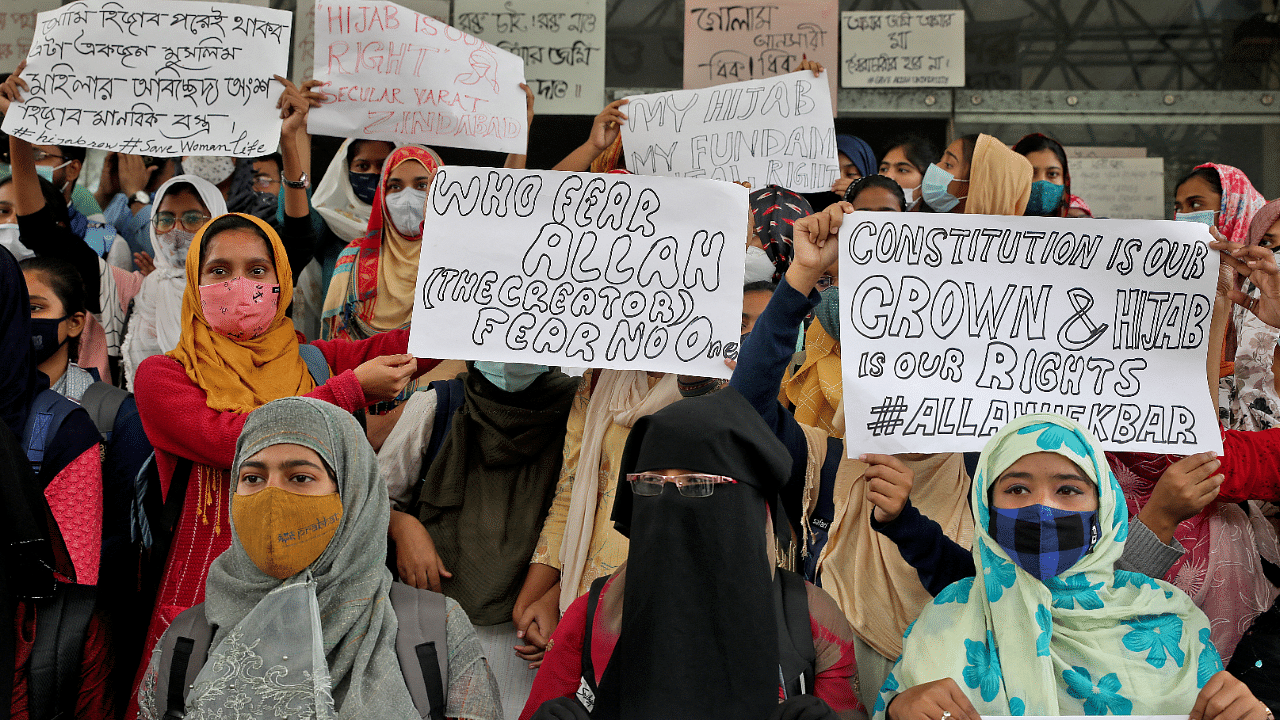
In the most recent development in Karnataka's hijab controversy, the full bench of the Karnataka High Court said in an interim order that no religious garments must be permitted on campuses until the court reaches a verdict.
The three-judge bench of Chief Justice Ritu Raj Awasthi, Justice J M Khazi and Justice Krishna S Dixit posted the matter for February 14. The bench was formed on Wednesday to hear the petitions by the Muslim girl students challenging the ban on Hijab after the single judge Justice Dixit referred the matter to the CJ with a view that a larger bench should hear the matter.
Here is a look at the controversy and other rulings related to religious attire in educational institutions.
Where did it all start?
The conflict began in September at a college preparatory institution for girls in Udupi, Karnataka when several Muslim students showed up in hijabs and some teachers whose class they tried to attend, turned them away and marked them absent for the day, according to the petition.
One of the petitioners said that wearing headscarves had not been an issue in prior years.
Students' parents encouraged their daughters to stand their ground, their lawyer Mohammed Tahir said. They continued to wear the hijab after the school Government Women’s PU in January called for a ban on it on school premises, saying it violated the school dress code.
Also Read | Karnataka High Court bars students from wearing saffron shawls, hijabs in classroom till further orders
In recent weeks, students have been routinely met at the campus gates by scores of boys and men wearing saffron protesting hijabs in schools. The unrest also spread to at least a dozen other schools in the state.
What is the government order?
On February 5, the Karnataka government ordered mandatory uniforms approved by the state government on school and college campuses, exercising its powers under Se133(2) of the Karnataka Education Act, 1983. While it is mandatory for the government schools’ students to wear uniforms approved by the government, those going to private colleges shall wear the uniform approved by the management.
The state government had exercised the same powers in 2013 to make uniforms compulsory for all educational institutions.
Referring to multiple judgments by various High Courts including Mumbai, Kerala and other states, the government order said, "Compelling a student to remove the headscarf on school campus does not amount to a violation under the Article 25 of the Indian Constitution. Also, reviewing the various provisions under the Karnataka Education Act 1983, the state government has the right to decide on the uniform in schools and colleges. As per the sub-clause 2 under section 133 of the Education Act 1983, it is mandatory for students of the government colleges to wear uniform approved by the state government."
According to a report by DH, a government official said the issue which is currently heard by the High Court of Karnataka pertains only to the Udupi College where the controversy erupted. "The state government's order is applicable to all the schools and colleges across Karnataka," the official said.
Previous rulings on religious attire in educational institutions:
The Karnataka government, in its order, cited rulings from three high courts – Kerala, Bombay, and Madras High Court.
Kerala High Court, 2018: Fathima Thasneem v State of Kerala
A petition was filed by two girls aged 12 and 8 who were represented by their father, who wanted his daughters to wear hijab and a full-sleeved shirt. The school, which was a Christian Missionary, had refused to allow the hijab. A single-judge bench had held that the “collective rights” of an institution would be given primacy over the individual rights of the petitioner.
Kerala High Court, 2015: Amnah Bint Basheer vs Central Board of Secondary:
The dress code prescribed by the CBSE for appearing in the All-India Pre-Medical Examination was being challenged in this petition. The Board had allowed only wearing half sleeve kurta/salvar to appear in the competitive examination. The petitioners – a Muslim girl and her father — challenged the prescription of the dress code on the ground of violation of fundamental rights as guaranteed under Article 25(1) of the Constitution. In this case, the court found that the dress code prescribed by the board was not based on any of the grounds on which the right to religion could be regulated.
The court allowed the petition but also safeguarded the interest of the Board by allowing the invigilator to frisk candidates by removing their scarf.
Bombay High Court, 2003: Fathema Hussain Sayed v Bharat Education Society
A minor student from an all-girls school had challenged the school’s prescribed dress code that did not allow her to wear a hijab. In her petition, she had argued that wearing a headscarf was an essential religious practice that should be protected under the Constitution. The Bombay High Court had ruled against the petitioner referring to a verse from Quran, saying that the book did not prescribe wearing a headscarf before other women.
“A girl student not wearing the head-scarf or head covering studying in exclusive girls section cannot be said to in any manner acting inconsistent with the aforesaid verse 31 or violating any injunction provided in Holy Quran,” the court said.
Madras High Court, 2004: Sir M Venkata Subba Rao, Matriculation Higher Secondary School Staff Assn v Sir M Venkata Subba Rao, Matriculation Higher Secondary:
The writ petition challenged the dress code of the teachers imposed by the management of the school. However, the Madras High Court ordered that the imposition of the dress code had no “statutory backing”. “The regulation of a dress code is only to maintain uniformity in discipline,” the court observed.
Watch the latest DH Videos here: